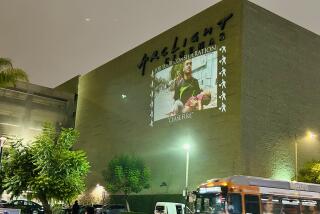Spotlighting Quiet Struggle of Oppressed
SAN DIEGO — Krzysztof Wodiczko’s public projections last weekend confronted both self-selected and arbitrary audiences with a potent visual experience, as well as a reminder of certain urgent social concerns.
On Friday evening, Wodiczko, a Polish-born artist now living in New York, targeted the Museum of Man in Balboa Park, projecting onto it a pair of hands sporting elegantly cuffed wrists and a gold ring. Each hand formed a fist around an ornate knife and fork, in a posture suggesting a demand to be served. Adjacent, on the California tower, an image of a basket of fruit and vegetables appeared, raised by arms that were bare but for handcuffs connecting them and a small, sickle-shaped fruit knife dangling from one wrist.
These images of the demanding, affluent patron and the cornucopia of delights served up by the oppressed reeked of class conflict and the quiet struggle of the enslaved. Against the facade of the Museum of Man--a repository of past cultures--Wodiczko’s work read as a concise, one-shot statement defining current culture, especially locally, where the servitude of undocumented workers supports the luxury and leisure of the enfranchised.
The exaggeration and immediate legibility of the imagery play a key role in the effectiveness of Wodiczko’s art, which is well documented in an exhibition at the La Jolla Museum of Contemporary Art (through March 13), sponsor of the artist’s local projections. The images at the Museum of Man, projected in color from three 1,000-watt projectors, exerted tremendous physical presence through their scale (up to 75 feet) and their accentuation of the architecture’s implicit anthropomorphic qualities. Bearing hands, the museum facade became a giant torso, the tower a massive standing figure.
In Tijuana on Saturday night, the relationship of image to structure was even more explicit, with the globe of the Centro Cultural’s Omnimax theater reading as an immense head, with hands clasped behind it as if the subject were under arrest. On either side of the central image were projected smaller, slightly dimmer question marks, framing the image as if posing an unwieldy question. The query directed itself not only to Mexican viewers whose own fate may have been pictured, if contemplating the surreptitious, illegal crossing to the United States, but also to Americans, whose security and livelihood such prosecution is designed to protect.
Because of its larger scale, this projection was even more physically impressive than the first, and its tremendous clarity allowed for greater scrutiny of the photographic image. As it turns out, the hands depicted could not have been those of a worker, as implied by the image’s context. Instead of showing the wear and tear of heavy usage, they were immaculately groomed, perhaps even manicured to their clean and smooth state, the fingers interlocked with grace, rather than tension.
Wodiczko has admitted that he arrives as a tourist at the sites of most of his projections, and the slightly cliched quality of these images, however powerful, reflects the brevity of his awareness of the issues concerned. The subjects Wodiczko takes on are far more complex than these works would suggest, in their evocation of clear-cut hierarchies and questionable prosecutions.
Where the projections do succeed is in calling public attention to these issues through a fascinating and technically refined vehicle of expression. To achieve a more lasting impact, however, Wodiczko must resolve a balance between immediate accessibility (dependent in part on the use of cliche) and a more complex, considered editorial statement. Until such an admittedly tenuous balance is reached, Wodiczko risks diluting his message for the sake of a more engaging spectacle.
More to Read
The biggest entertainment stories
Get our big stories about Hollywood, film, television, music, arts, culture and more right in your inbox as soon as they publish.
You may occasionally receive promotional content from the Los Angeles Times.










